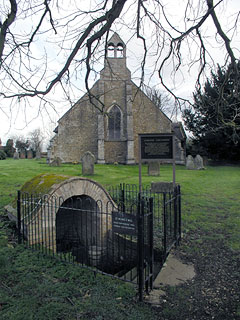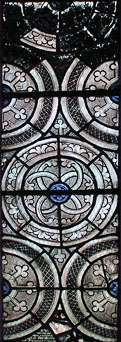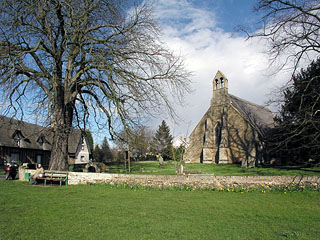There are a number of villages in Cambridgeshire which once contained more than one parish, and therefore more than one church. Such arrangements are burdensome to a small community and in most cases the parishes were united long ago. In Longstanton the two parish situation survived until 1953 when the grand All Saints (on the main crossroads of the village) became the sole parish church and the smaller St Michael (stuck away on the edges of the built-up area) was made redundant.
Why was this so late in the day? One answer could lie in the fact that there were originally two villages here that grew together over time: Straggling Longstanton lives up to that 'long' in it's name. Even so, the St Michael end can never have been very large, and parishes in this bit of the world often incorporate outlying hamlets. Why didn't All Saints swallow up its diminutive cousin earlier? At Duxford, St John remained in use until the late 19th century because the parishioners held it in great affection. Perhaps the same is true here.
I can understand why people would love this church - I found it instantly endearing. It is small - a towerless nave and little chancel, sitting in a slightly overgrown churchyard. The nave is broad and low - it has aisles, but no clerestory, with the result that the roof is a great hill of thatch. The west wall is rather severe as a result - two heavy-looking buttresses flank the little west window, but there are no windows at the ends of the aisles. Above the centre sits a little 17th century bell-cote - apparently the two bells (one of them dating to the 15th century) survived here until they were stolen in 1969.
We entered through the priest's door. Buildings in the care of the Churches Conservation Trust are often characterised by a sort of austere beauty, and St Michael is no exception. Low benches fill the eastern end of the nave, and the bare bones of the liturgical furniture remain, but there is no question that this is a dormant church. (As it happens, when we visited in the early spring of 2004 All Saints was closed for urgent repairs, and so St Michael was playing host to a congregation once again - but I suspect that's not a very frequent occurrence.) Personally, my favourite churches are often like this: serene and empty. It isn't 'authentic' - but then, what does authenticity consist in when we have a building that has lasted for so many years and seen so many changes? And why would it matter, even if we could identify it? St Michael in the middle ages would have been a dark, smoky, colourful place. I looked at the whitewash above the nave arcades and wondered whether it hides any wall paintings like those discovered at Ickleton in 1979. To see churches in their pre-Reformation state would be exciting, both on an emotional and an intellectual level. But this quietness is a fine thing too, and no less holy.
Aside from soaking up the atmosphere, there's not much to see in the nave. It was built in the early 14th century, and has the familiar pattern of alternating octagonal and circular piers. The aisle roofs go down very low indeed - for the most part, the aisle windows are small and let in little light. The exceptions are the easternmost windows in the north and south walls respectively. Both are quite large and filled with elegant Decorated tracery - they sit inside little gables, which makes them look almost like transepts. It's quite an unusual arrangement, and the guidebook suggests that it was a Victorian innovation.
The chancel contains several interesting bits and pieces - it was rebuilt in 1884, but both Pevsner and the church guide believe that it was faithful to the original. It is raised a little above the floor-level of the nave: in the middle is set a brass inscription, commemorating Thomas Burgoyne, a lord of the manor and one time patron of the church. The Latin is translated as 'As you are now so once was I; as I am, so will you be.' [Mark adds: this sentiment can be found almost everywhere in christian countries, mocking at our security and calling us to consider how brief and potentially meaningless our existence may be. There's a splendid example in the Night Oratory of St Catherine under the vaults of the Ospedale of Santa Maria della Scala in Siena - a small glass fronted niche contains the skull of one of the lay fraternity who met there, above its grin are crudely stencilled the same words, in italian, as appear on the floor of this small rural church in Cambridgeshire...]
Next to the high altar is a very fine double piscina: an arch composed of several lines of moulding rises from either side, and is intersected by two half-arches coming from a small shaft in the middle. This creates two pointed arches which contain the basins, and a lot of interesting lines weaving in and out of each other in the space above. It is very similar to the more elaborate piscina at Histon, though this seems a little bit later to me: the Histon arches are almost perfectly semi-circular, whereas here they come to a slight but noticeable point.
Most interestingly of all, the westernmost window in the north wall of the chancel contains some 13th century glass - the earliest paintedglass I've come across in the entire county. The technique used here is one called grisaille, which consists of painting clear glass with grey (or greenish-grey) pigment and then decorating over the top with complex designs of leaves and flowers, usually in strict geometry (the best example I've seen before is the incomparably beautiful Five Sisters window at York Minster). Here at St Michael, only the top half is original, and it's a bit blackened, but I thought it was wonderful anyway.
Before you leave St Michael, you can pay your respects to St Michael's Well. This sits in a little brick vault in the northwest corner of the churchyard. It is fed by a little spring, and has been here for a long time - the vault has been restored, but the stone lining of the well itself looks ancient. Children were baptised here as late as the 1880s, submersed in the cold water. According to tradition, the priest would not make the sign of the cross until the sun had shone through a little cross-shaped slit in the roof. Such traditions are exciting, and have a pleasing 'dawn-of-time' ring to them, though a small sceptical voice in the back of my mind says 'That's what the sort of 19th century antiquarians who invent such things would have thought, too…'
The presence of a holy well is an intriguing thing in itself. The water from such wells was held to cure wounds and disease, and drinking from a holy well could inspire the power of prophecy. Such traditions are much older than the 19th century - much older even than Christianity. Dedications to St Michael are rare in Cambridgeshire, but they are common in the west country: the warrior archangel sits high on the sacred hills, conquering the ancient gods and banishing them even from memory. All that remains is a whisper: the memory of prophecy in the waters of a well, and a cure for warts.
So, was Longstanton a pre-Christian religious site? We don't know, of course. A board in the church tries to place Longstanton on the Great Ley that runs through (amongst other places) St Michael's Mount, Glastonbury and Avebury, but this line runs nowhere near Longstanton. Modern antiquarians, like their Victorian counterparts, tend to let their enthusiasm get the better of them. Still, in the sunshine on that spring day I thought of St Michael, and of the holy well, and I could imagine dragons dozing here in the warmth.
St Michael is kept locked, but there are several keyholders indicated.




